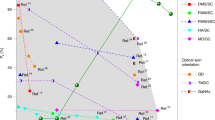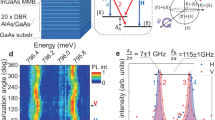Abstract
The spin of an electron is a promising memory state and qubit. Connecting spin states that are spatially far apart will enable quantum nodes and quantum networks based on the electron spin. Towards this goal, an integrated spin–photon interface would be a major leap forward as it combines the memory capability of a single spin with the efficient transfer of information by photons. Here, we demonstrate such an efficient and optically programmable interface between the spin of an electron in a quantum dot and photons in a nanophotonic waveguide. The spin can be deterministically prepared in the ground state with a fidelity of up to 96%. Subsequently, the system is used to implement a single-spin photonic switch, in which the spin state of the electron directs the flow of photons through the waveguide. The spin–photon interface may enable on-chip photon–photon gates, single-photon transistors and the efficient generation of a photonic cluster state.
This is a preview of subscription content, access via your institution
Access options
Access Nature and 54 other Nature Portfolio journals
Get Nature+, our best-value online-access subscription
$29.99 / 30 days
cancel any time
Subscribe to this journal
Receive 12 print issues and online access
$259.00 per year
only $21.58 per issue
Buy this article
- Purchase on Springer Link
- Instant access to full article PDF
Prices may be subject to local taxes which are calculated during checkout




Similar content being viewed by others
References
Kimble, H. J. The quantum internet. Nature 453, 1023–1030 (2008).
Duan, L. M. & Kimble, H. J. Scalable photonic quantum computation through cavity-assisted interactions. Phys. Rev. Lett. 92, 127902 (2004).
Van Meter, R., Ladd, T. D., Fowler, A. G. & Yamamoto, Y. Distributed quantum computation architecture using semiconductor nanophotonics. Int. J. Quantum Inf. 8, 295–323 (2010).
Hacker, B., Welte, S., Rempe, G. & Ritter, S. A photon–photon quantum gate based on a single atom in an optical resonator. Nature 536, 193–196 (2016).
Delteil, A. et al. Generation of heralded entanglement between distant hole spins. Nat. Phys. 12, 218–223 (2016).
Hucul, D. et al. Modular entanglement of atomic qubits using photons and phonons. Nat. Phys. 11, 37–42 (2015).
Sipahigil, A. et al. An integrated diamond nanophotonics platform for quantum-optical networks. Science 354, 847–850 (2016).
Cirac, J. I., Zoller, P., Kimble, H. J. & Mabuchi, H. Quantum state transfer and entanglement distribution among distant nodes in a quantum network. Phys. Rev. Lett. 78, 3221–3224 (1997).
Lodahl, P., Mahmoodian, S. & Stobbe, S. Interfacing single photons and single quantum dots with photonic nanostructures. Rev. Mod. Phys. 87, 347–400 (2015).
Arcari, M. et al. Near-unity coupling efficiency of a quantum emitter to a photonic crystal waveguide. Phys. Rev. Lett. 113, 093603 (2014).
Claudon, J. et al. A highly efficient single-photon source based on a quantum dot in a photonic nanowire. Nat. Photon. 4, 174–177 (2010).
Makhonin, M. et al. Waveguide coupled resonance fluorescence from on-chip quantum emitter. Nano Lett. 14, 6997–7002 (2014).
Ding, X. et al. On-demand single photons with high extraction efficiency and near-unity indistinguishability from a resonantly driven quantum dot in a micropillar. Phys. Rev. Lett. 116, 020401 (2016).
Kiršanské, G. et al. Indistinguishable and efficient single photons from a quantum dot in a planar nanobeam waveguide. Phys. Rev. B 96, 165306 (2017).
Javadi, A. et al. Single-photon non-linear optics with a quantum dot in a waveguide. Nat. Commun. 6, 8655 (2015).
Bennett, A. et al. A semiconductor photon-sorter. Nat. Nanotech. 11, 857–860 (2016).
Luxmoore, I. J. et al. Interfacing spins in an InGaAs quantum dot to a semiconductor waveguide circuit using emitted photons. Phys. Rev. Lett. 110, 037402 (2013).
Söllner, I. et al. Deterministic photon-emitter coupling in chiral photonic circuits. Nat. Nanotech. 10, 775–778 (2015).
Coles, R. et al. Chirality of nanophotonic waveguide with embedded quantum emitter for unidirectional spin transfer. Nat. Commun. 7, 11183 (2016).
Lodahl, P. et al. Chiral quantum optics. Nature 541, 473–480 (2017).
Kroutvar, M. et al. Optically programmable electron spin memory using semiconductor quantum dots. Nature 432, 81–84 (2004).
Atatüre, M. et al. Quantum-dot spin-state preparation with near-unity fidelity. Science 312, 551–553 (2006).
Warburton, R. J. Single spins in self-assembled quantum dots. Nat. Mater. 12, 483–493 (2013).
Press, D. et al. Ultrafast optical spin echo in a single quantum dot. Nat. Photon. 4, 367–370 (2010).
Stockill, R. et al. Quantum dot spin coherence governed by a strained nuclear environment. Nat. Commun. 7, 12745 (2016).
Pinotsi, D., Fallahi, P., Miguel-Sanchez, J. & Imamoglu, A. Resonant spectroscopy on charge tunable quantum dots in photonic crystal structures. IEEE J. Quant. Electron 47, 1371–1374 (2011).
Carter, S. G. Quantum control of a spin qubit coupled to a photonic crystal cavity. Nat. Photon. 7, 329–334 (2013).
Sweeney, T. M. et al. Cavity-stimulated Raman emission from a single quantum dot spin. Nat. Photon. 8, 442–447 (2014).
Sun, S., Kim, H., Solomon, G. S. & Waks, E. A quantum phase switch between a single solid-state spin and a photon. Nat. Nanotech. 11, 539–544 (2016).
Emary, C., Xu, X., Steel, D. G., Saikin, S. & Sham, L. J. Fast initialization of the spin state of an electron in a quantum dot in the Voigt configuration. Phys. Rev. Lett. 98, 047401 (2007).
Chang, D. E., Sørensen, A. S., Demler, E. A. & Lukin, M. D. A single-photon transistor using nanoscale surface plasmons. Nat. Phys. 3, 807–812 (2007).
Scheucher, M., Hilico, A., Will, E., Volz, J. & Rauschenbeutel, A. Quantum optical circulator controlled by a single chirally coupled atom. Science 354, 1577–1580 (2016).
Mahmoodian, S., Lodahl, P. & Sørensen, A. S. Quantum networks with chiral-light–matter interaction in waveguides. Phys. Rev. Lett. 117, 240501 (2016).
Dreiser, J. et al. Optical investigations of quantum dot spin dynamics as a function of external electric and magnetic fields. Phys. Rev. B 77, 075317 (2008).
Löbl, M. C. et al. Narrow optical linewidths and spin pumping on charge-tunable, close-to-surface self-assembled quantum dots in an ultra-thin diode. Phys. Rev. B 96, 165440 (2017).
Kuhlmann, A. V. et al. Charge noise and spin noise in a semiconductor quantum device. Nat. Phys. 9, 570–575 (2013).
Warburton, R. J. et al. Optical emission from a charge-tunable quantum ring. Nature 405, 926–929 (2000).
Smith, J. M. et al. Voltage control of the spin dynamics of an exciton in a semiconductor quantum dot. Phys. Rev. Lett. 94, 197402 (2005).
Kurzmann, A., Ludwig, A., Wieck, A. D., Lorke, A. & Geller, M. Auger recombination in self-assembled quantum dots: quenching and broadening of the charged exciton transition. Nano Lett. 16, 3367–3372 (2016).
Kroner, M. et al. Resonant two-color high-resolution spectroscopy of a negatively charged exciton in a self-assembled quantum dot. Phys. Rev. B 78, 075429 (2008).
Wüst, G. et al. Role of the electron spin in determining the coherence of the nuclear spins in a quantum dot. Nat. Nanotech. 11, 885–889 (2016).
Fushman, I. et al. Controlled phase shifts with a single quantum dot. Science 320, 769–772 (2008).
Volz, T. et al. Ultrafast all-optical switching by single photons. Nat. Photon. 6, 605–609 (2012).
Nozaki, K. et al. Sub-femtojoule all-optical switching using a photonic-crystal nanocavity. Nat. Photon. 4, 477–483 (2010).
Miller, D. A. Are optical transistors the logical next step? Nat. Photon. 4, 3–5 (2010).
Lodahl, P. Quantum-dot based photonic quantum networks. Quantum Sci. Technol. 3, 013001 (2018).
Lindner, N. H. & Rudolph, T. Proposal for pulsed on-demand sources of photonic cluster state strings. Phys. Rev. Lett. 103, 113602 (2009).
Kroner, M. et al. Optical detection of single-electron spin resonance in a quantum dot. Phys. Rev. Lett. 100, 156803 (2008).
Hansom, J. et al. Environment-assisted quantum control of a solid-state spin via coherent dark states. Nat. Phys. 10, 725–730 (2014).
Xu, X. et al. Optically controlled locking of the nuclear field via coherent dark-state spectroscopy. Nature 459, 1105–1109 (2009).
Éthier-Majcher, G. et al. Improving a solid-state qubit through an engineered mesoscopic environment. Phys. Rev. Lett. 119, 130503 (2017).
Acknowledgements
We acknowledge N. J. Taba and C. L. Dreeßen for help during the initial stages of the measurements. We gratefully acknowledge financial support from the European Research Council (ERC Advanced Grant 'SCALE'), Innovation Fund Denmark (Quantum Innovation Center 'Qubiz') and the Danish Council for Independent Research. I.S., M.C.L. and R.J.W. acknowledge support from SNF (project 200020_156637) and NCCR QSIT. A.L. and A.D.W. gratefully acknowledge support of BMBF (Q.com-H 16KIS0109) and the DFG (TRR 160). This project has received funding from the European Union’s Horizon 2020 research and innovation programme under the Marie Skłodowska-Curie grant agreement no. 747866 (EPPIC) and no. 753067 (OPHOCS).
Author information
Authors and Affiliations
Contributions
A.J., D.D., M.H.A. and T.S. carried out the optical experiment with input from I.S., R.J.W. and P.L. A.J., M.H.A. and S.M. performed the theory. M.C.L., I.S., A.L. and R.J.W. designed the heterostructure. R.S., A.L. and A.D.W. grew the wafer. C.P., T.P., S.S. and L.M. designed and fabricated the sample. A.J. and P.L. wrote the manuscript with input from all authors.
Corresponding authors
Ethics declarations
Competing interests
The authors declare no competing interests.
Additional information
Publisher’s note: Springer Nature remains neutral with regard to jurisdictional claims in published maps and institutional affiliations.
Supplementary information
Supplementary Information
Supplementary Text and Supplementary Figures 1–10.
Rights and permissions
About this article
Cite this article
Javadi, A., Ding, D., Appel, M.H. et al. Spin–photon interface and spin-controlled photon switching in a nanobeam waveguide. Nature Nanotech 13, 398–403 (2018). https://doi.org/10.1038/s41565-018-0091-5
Received:
Accepted:
Published:
Issue Date:
DOI: https://doi.org/10.1038/s41565-018-0091-5
This article is cited by
-
A diamond nanophotonic interface with an optically accessible deterministic electronuclear spin register
Nature Photonics (2024)
-
Giant optical polarisation rotations induced by a single quantum dot spin
Nature Communications (2024)
-
On-chip spin-photon entanglement based on photon-scattering of a quantum dot
npj Quantum Information (2023)
-
Revealing broken valley symmetry of quantum emitters in WSe2 with chiral nanocavities
Nature Communications (2023)
-
A chiral one-dimensional atom using a quantum dot in an open microcavity
npj Quantum Information (2022)



